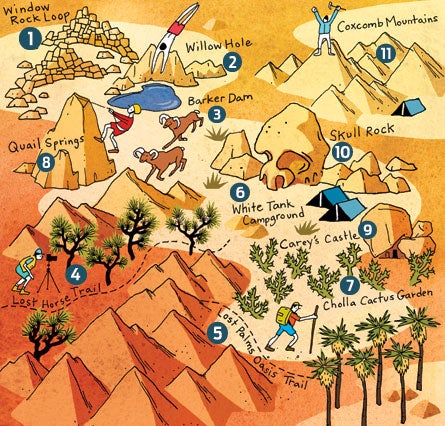Our Backyard: Joshua Tree National Park, California

OUR BACKYARD | THE EXPERTS
1. Top Dayhike
The 6.5-mile Window Rock Loop wanders through a maze of boulder formations, slot canyons, and Joshua Tree forests. Look for natural walls stacked straight like manmade bricks at mile .7 and a massive granite fin with a house-size window cut into its face at mile 3.9. Bring a detailed map and solid navigation skills: Crisscrossing washes make this route confusing.
2. No Swimming Holes!
In the printed version of this article, we mistakenly identified Willow Hole as a swimming area. In fact, there are no swimming holes in Joshua Tree: All water must be reserved for wildlife, as it is scarce and often seasonal. Instead, approach the hike quietly in hopes of spotting animals who use it, like desert bighorn sheep. BACKPACKER sincerely regrets the error.
3. Most Wildlife
Greg Russell (below) loves photographing desert bighorns in Joshua Tree, where the dark sheep “look regal” against the light granite backdrop. For guaranteed shots, he heads for the 1.8-mile Barker Dam Loop Trail, where he never fails to see at least one of his favorite subjects.
4. Best Joshua Trees
The eerie trees reminded Mormon settlers of biblical Joshua’s hands praying skyward. In cooler spring, start the five-mile round-trip Lost Horse Trail from Ryan campground at 4 a.m. to catch these mystical trees (found only in the Mojave Desert) in the best light—sunrise.

OUR BACKYARD | THE EXPERTS
5. Top Seaside View
At mile 3.3 on the 3.7-mile Lost Palms Oasis Trail, follow a short spur right to an overlook. Look south: You’ll see the landlocked Salton Sea glittering 70 miles away.
6. Favorite Campground
White Tank (15 sites) has all of the beauty and none of the crowds of Jumbo Rocks (124 sites). Bonus: Scramble up 12-foot-tall, 30-foot-wide Arch Rock.
7. Coolest Cactus
Wander the quarter-mile Cholla Cactus Loop to get a close gander at this dense forest of fuzzy oddities. But keep your distance: It’s also known as the “jumping cholla” because needles detach so easily they seem to launch from plant to skin before you can even touch it.
8. Best Beginner Crags
With easy bouldering and routes starting at 5.1, the Quail Springs picnic area is an ideal playground for fledgling climbers. Easy access to cliff tops makes for great top-roping. Joshua Tree Climbing School owner Mark Bowling recommends Sail Away (5.7+).
9. Secret Hideout
“Carey’s Castle,” a prospector’s home built straight into boulders and abandoned in the 1940s, still stands. Get there: On I-10, exit Hayfield, turn left after 1.1 miles, and follow a dirt road for 1.7 miles before turning left into a parking area. Bushwhack through brush and boulders on a “secret” nine-miler in the park’s remote southwest section, says Hal Summers (below).
10. Spookiest Formation
Skull Rock, reachable by a 1.5-mile, one-way ramble just off Jumbo Rocks campground, serves as a creepy photo subject—and a terrifying reminder of what hikers who forget water look like (local tip: 100 oz. per person per day).
OUR BACKYARD | THE EXPERTS
With Joshua Tree’s south entrance a mere 74 miles away, University of California-Riverside biology professor Greg Russell, 31, goes from campus to cactus in less than two hours. Once there, he moonlights as a pro photographer, using his day-job skills to locate elusive wildlife—like kangaroo rats, desert bighorns, and poorwills—at dusk near water-rich areas like Barker Dam.
In 2009 Hal Summers, 50, made a resolution to hike every day for a year. He succeeded, trekking “well over 100 miles” through Joshua Tree, located less than an hour away from his home in Indian Wells, California. He loves J-Tree’s bushwhacking: “It’s possible to hike cross-country in the desert very easily—just pick a ridge or canyon and go.” (See Summers’ complete hiking diary at hikeeveryday.blogspot.com.)